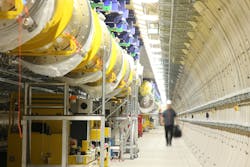X-ray free-electron lasers could assist in achieving practical nuclear fusion
Many paths have been taken in attempts to achieve controlled nuclear fusion, some based on laser-driven inertial confinement, and numerous others based on magnetic confinement. None have achieved the goal of practical nuclear fusion (not just a gain of greater than unity, but a gain large enough to overcome electrical inefficiencies in the fusion device). Triggering nuclear fusion requires that the strong electrical repulsion between identically charged atomic nuclei be overcome, ordinarily requiring high energies. But it is also possible to overcome this repulsion through quantum-mechanical tunneling, an approach being pursued by physicists at the Helmholtz-Zentrum Dresden-Rossendorf (HZDR; Dresden, Germany).
For example, in deuterium-tritium fusion (the easiest type of fusion to achieve) and for kinetic energies in the kiloelectronvolt (keV) range, fusion ordinarily occurs extremely slowly due to the Coulomb barrier between the nuclei. The HZDR scientists are interested in determining if adding the electromagnetic field from the beam of an x-ray free-electron laser (XFEL), in essence overlaying a weaker rapidly changing electromagnetic field over the strong electric field that is causing the repulsion between the nuclei, could increase the possibility of quantum-mechanical tunneling enough to make fusion practical on Earth. (In the Sun, it is already practical, as temperature and pressure conditions in the Sun’s core are not high enough to overcome the energy barrier directly, but require quantum-mechanical tunneling as assistance.) They have found that the electromagnetic field strengths and frequencies of XFELs, either present-day or near-future, could reach the magnitudes necessary to reach this goal. Existing XFELs can already achieve power densities of 1020 W/cm2; the most powerful of this type is the European XFEL in Hamburg. Testing the physicists' predictions would be done at the laser's Helmholtz International Beamline for Extreme Fields (HIBEF). Reference: F. Queisser and R. Schützhold, Phys. Rev. C (2019); doi:10.1103/PhysRevC.100.041601.
About the Author
John Wallace
Senior Technical Editor (1998-2022)
John Wallace was with Laser Focus World for nearly 25 years, retiring in late June 2022. He obtained a bachelor's degree in mechanical engineering and physics at Rutgers University and a master's in optical engineering at the University of Rochester. Before becoming an editor, John worked as an engineer at RCA, Exxon, Eastman Kodak, and GCA Corporation.

